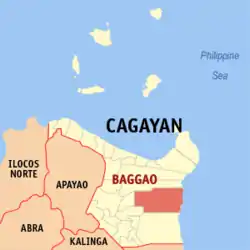Baggao
Baggao, officially the Municipality of Baggao (Ibanag: Ili nat Baggao; Ilocano: Ili ti Baggao; Tagalog: Bayan ng Baggao), is a 1st class municipality in the province of Cagayan, Philippines. According to the 2015 census, it has a population of 82,782 people. [3]
Baggao | |
|---|---|
| Municipality of Baggao | |
 Seal | |
 Map of Cagayan with Baggao highlighted | |
OpenStreetMap 
| |
.svg.png.webp) Baggao Location within the Philippines | |
| Coordinates: 17°53′22″N 121°52′15″E | |
| Country | |
| Region | Cagayan Valley (Region II) |
| Province | Cagayan |
| District | 1st District |
| Barangays | 48 (see Barangays) |
| Government | |
| • Type | Sangguniang Bayan |
| • Mayor | Joan C. Dunuan |
| • Vice Mayor | Rowel B. Gazmen |
| • Representative | Ramon C. Nolasco Jr. |
| • Electorate | 47,055 voters (2019) |
| Area | |
| • Total | 920.60 km2 (355.45 sq mi) |
| Elevation | 51 m (167 ft) |
| Population | |
| • Total | 82,782 |
| • Density | 90/km2 (230/sq mi) |
| • Households | 19,282 |
| Economy | |
| • Income class | 1st municipal income class |
| • Poverty incidence | 13.42% (2015)[4] |
| • Revenue | ₱262,775,219.38 (2016) |
| Time zone | UTC+8 (PST) |
| ZIP code | 3506 |
| PSGC | |
| IDD : area code | +63 (0)78 |
| Climate type | tropical monsoon climate |
| Native languages | Ibanag Ilocano Cagayan Agta Dupaningan Agta Tagalog |
Barangays
Baggao is politically subdivided into 48 barangays.
- Adaoag
- Agaman (Norte)
- Agaman (Sur)
- Agaman (Proper)
- Alba
- Annayatan
- Asassi
- Asinga-Via
- Awallan
- Bacagan
- Bagunot
- Barsat East
- Barsat West
- Bitag Grande
- Bitag Pequeño
- Bunugan
- Canagatan
- Carupian
- Catugay
- Poblacion (Centro)
- Dabbac Grande
- Dalin
- Dalla
- Hacienda Intal
- Ibulo
- Immurung
- J. Pallagao
- Lasilat
- Masical
- Mocag
- Nangalinan
- Remus
- San Antonio
- San Francisco
- San Isidro
- San Jose
- San Miguel
- San Vicente
- Santa Margarita
- Santor
- Taguing
- Taguntungan
- Tallang
- Temblique
- Taytay
- Tungel
- Mabini
- Agaman Norte
- Agaman Sur
- C. Verzosa (Valley Cove)
Demographics
| Year | Pop. | ±% p.a. |
|---|---|---|
| 1903 | 3,857 | — |
| 1918 | 6,727 | +3.78% |
| 1939 | 11,602 | +2.63% |
| 1948 | 11,232 | −0.36% |
| 1960 | 21,597 | +5.60% |
| 1970 | 36,471 | +5.37% |
| 1975 | 41,011 | +2.38% |
| 1980 | 44,081 | +1.45% |
| 1990 | 55,264 | +2.29% |
| 1995 | 60,060 | +1.57% |
| 2000 | 66,264 | +2.13% |
| 2007 | 73,048 | +1.35% |
| 2010 | 78,188 | +2.51% |
| 2015 | 82,782 | +1.09% |
| Source: Philippine Statistics Authority [3] [5] [6][7] | ||
In the 2015 census, the population of Baggao, Cagayan, was 82,782 people, [3] with a density of 90 inhabitants per square kilometre or 230 inhabitants per square mile.
Climate
| Climate data for Baggao, Cagayan | |||||||||||||
|---|---|---|---|---|---|---|---|---|---|---|---|---|---|
| Month | Jan | Feb | Mar | Apr | May | Jun | Jul | Aug | Sep | Oct | Nov | Dec | Year |
| Average high °C (°F) | 24 (75) |
25 (77) |
28 (82) |
31 (88) |
31 (88) |
31 (88) |
30 (86) |
30 (86) |
29 (84) |
28 (82) |
26 (79) |
24 (75) |
28 (83) |
| Average low °C (°F) | 20 (68) |
20 (68) |
21 (70) |
23 (73) |
24 (75) |
24 (75) |
24 (75) |
24 (75) |
24 (75) |
23 (73) |
23 (73) |
21 (70) |
23 (73) |
| Average precipitation mm (inches) | 150 (5.9) |
106 (4.2) |
84 (3.3) |
48 (1.9) |
103 (4.1) |
115 (4.5) |
134 (5.3) |
156 (6.1) |
136 (5.4) |
240 (9.4) |
246 (9.7) |
300 (11.8) |
1,818 (71.6) |
| Average rainy days | 19 | 14.3 | 12.8 | 10.8 | 17.7 | 18.9 | 21.5 | 23.3 | 22.1 | 20.4 | 20.3 | 22.2 | 223.3 |
| Source: Meteoblue [8] | |||||||||||||
References
- Municipality of Baggao | (DILG)
- "Province: Cagayan". PSGC Interactive. Quezon City, Philippines: Philippine Statistics Authority. Retrieved 12 November 2016.
- Census of Population (2015). "Region II (Cagayan Valley)". Total Population by Province, City, Municipality and Barangay. PSA. Retrieved 20 June 2016.
- "PSA releases the 2015 Municipal and City Level Poverty Estimates". Quezon City, Philippines. Retrieved 1 January 2020.
- Census of Population and Housing (2010). "Region II (Cagayan Valley)". Total Population by Province, City, Municipality and Barangay. NSO. Retrieved 29 June 2016.
- Censuses of Population (1903–2007). "Region II (Cagayan Valley)". Table 1. Population Enumerated in Various Censuses by Province/Highly Urbanized City: 1903 to 2007. NSO.
- "Province of Cagayan". Municipality Population Data. Local Water Utilities Administration Research Division. Retrieved 17 December 2016.
- "Baggao, Cagayan: Average Temperatures and Rainfall". Meteoblue. Retrieved 27 October 2018.
External links
This article is issued from Wikipedia. The text is licensed under Creative Commons - Attribution - Sharealike. Additional terms may apply for the media files.